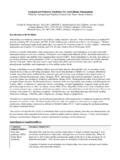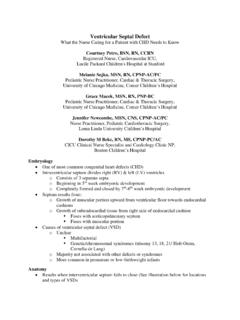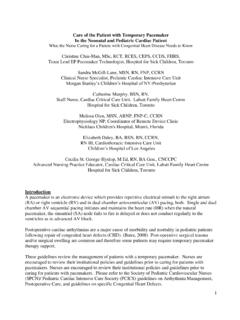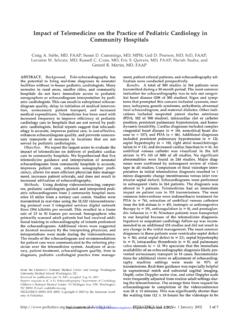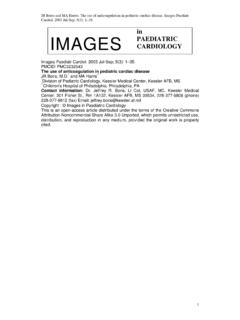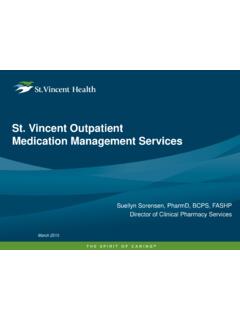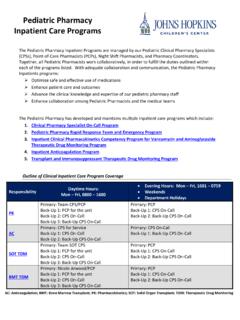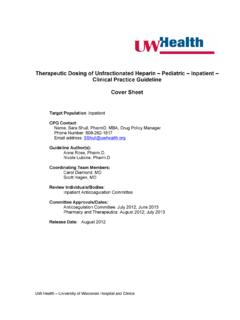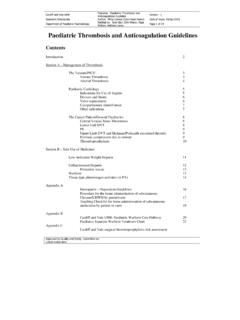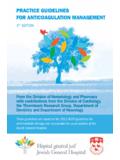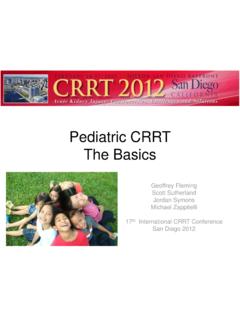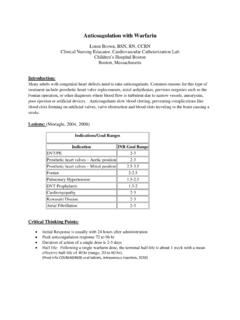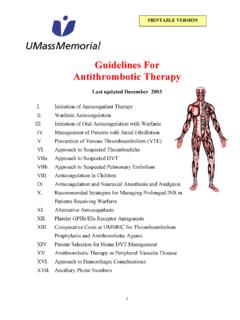Transcription of Anticoagulation in Pediatric Cardiology - pcics.org
1 1 Anticoagulation in Pediatric Cardiology Loren Brown, BSN, RN, CCRN, Boston Children s Hospital Jenna Murray, MSN, RN, CPNP-AC, Lucile Packard Children s Hospital Stanford, Kaye Remo, RN, University of California San Francisco Benioff Children s Hospital Mary Rummell MN, RN, CNS, CPNP, FAHA, Oregon Health and Science University Introduction: The use of antithrombotic therapy in neonates, infants, and children is increasing. This increase is multifactorial involving the prevalence of patients hospitalized with congenital heart disease (CHD); the increase in survival from both surgical and catheter interventions used to address complex CHD; and recognized improvement in outcomes with antithrombotic prophylaxis. Recognition of the potentially left-threatening complication of thrombosis is evident in patients with CHD and acquired heart disease.
2 These high-risk groups include patients with shunt-dependent single ventricles, post-operative central lines, Fontan circulation, arrhythmias, Kawasaki disease with coronary aneurysms, and cardiomyopathy/myocarditis. (Diab 2013; Giglia 2013; Monagle, 2012 Supp) Anticoagulation for Pediatric patients with mechanical valves, although historically more prevalent, continues to present management challenges for the caregiver and professional. Critical Thinking Points: (Biss 2013; Giglia 2013; Rummell 2013) Normal developmental changes in the hemostatic system Different physiological, pharmacological, and genetic response to medication management Difficulty administering anticoagulant therapy related to lack of suitable preparations Difficulty monitoring due to physiologically abnormal baseline tests and problems obtaining appropriate samples of blood Increased risk for bleeding complications related to cardiac pathophysiology and interventions Lack of randomized, controlled trials to guide therapy Breakdown of Critical Thinking Points: (Giglia 2013) Developmental changes Neonatal antithrombin levels are <50% of adult levels do not reach adult levels until approximately 6 months of age.
3 Neonatal altered platelet function hyporeactive to platelet-activating agents: thrombin, adenosine, phosphate/epinephrine, and thromboxane A2. However, the 2 bleeding time in neonates, a reflection of platelet function, is normal because of increased RBC size, Hematocrit and vWF multimers. Different levels of constituent proteins and inhibitors of coagulation (Decreased FII, FVII, FIX, FXI, FXII, protein C, protein S) and fibrinolysis varies with age. o Greater difference in patients < 3 months. o Reach adult levels at approximately 5 years. o Greater impact with cyanotic defects. Physiologically decreased plasma levels of vitamin K-dependent factors. Syndromes that have an effect on coagulation microdeletion syndrome Jacobsen Noonan thrombocytopenia, platelet dysfunction Multiple coagulation factor deficiencies FXI Congenital or acquired decrease in hemostatic protein(s) Cardiac conditions and associated issues CHD especially cyanotic conditions, abnormal blood flow, decreased vessel diameter Invasive cardiovascular (CV) procedures Indwelling vascular devices catheters, stents, transvenous pacemaker, septal occluders, and valves -- alter the blood flow shear stress, disrupt the endothelium, and activate the coagulation system.
4 Inflammatory response to ECMO and bypass circuits, deep hypothermic circulatory arrest Increased usage of blood product transfusion Surgically created conduits and shunts Excessive fibrinolysis, hypothermia, acidosis, decreased platelet count Liver congestion results in decreased vitamin K-dependent proteins, including proteins C & S, decreased metabolism of anticoagulants Decreased renal function decreased clearance of anticoagulants Heparin resistance o Secondary to antithrombin consumption and to competitive heparin binding to inflammation-related circulating proteins. Longer storage of blood products esp. RBCs results in disruption of coagulation factors Laboratory tests Samples drawn from central lines and arterial lines may be contaminated with heparin and falsely elevated the levels, should confirm with peripheral stick sampling 3 D-dimers (indicative of active coagulation and fibrin production in adults) not formally evaluated in children Heparin Levels o ACT , TOTEM, and TEG no well-designed studies to evaluate safety and efficacy of use of ACT to monitor Anticoagulation in children used for ECMO and CP bypass o Anti-Factor Xa Levels Used to measure the effect of UFH and LMWH on coagulation levels extrapolated from adult studies.
5 NO Pediatric studies establishing the safety and efficacy of any laboratory test to measure the effects of heparin. Poor correlation between heparin levels and PTT. LMWH is a short-chain heparin that does not influence the PTT. Therefore, the anti-Factor Xa level is the ONLY measure of the effect of LMWH therap International Normalized Ratio (INR) o Ultimately this means that no matter how or where the lab is drawn it can be compared to another INR o All people, regardless of Anticoagulation status, have a baseline INR around 1 o Many centers draw a baseline INR and CBC before initial dose of anticoagulant o If the baseline INR is > (which is common at times in the Fontan and post-pump population) LFTs should be checked as well. INRs post bypass can be falsely elevated due to heightening of the coagulation cascade at this time Indications for Anticoagulation : (Monagle 2004, 2008; Giglia 2013) 4 Specialized Guidelines Anticoagulation in the immediate post-operative period:(Giglia 2013; Diab 2013; Biss 2013.)
6 Monagle 2011, Personal communication, Karamlou, T) Neonates: Systemic pulmonary Shunts o Placement criteria Palliation in two ventricle repair (Tetralogy of Fallot, severe pulmonary stenosis or right ventricular outflow obstruction,) Include in initial stage I palliation for single ventricle (Hypoplastic right or left ventricle) o Preferred material - polytetrafluoroethylene (Gortex ) o Post procedure complications: Significant risk Thrombosis Most significant cause and/or contributor to shunt failure. Associated with hypovolemia related to: o Bleeding o Pleural drainage o Infection Complicated with coagulopathies Assessment includes: Both partial thrombosis/full thrombosis Decreasing and uncorrectable oxygen saturations Marked hypoxemia and decreased cardiac output Management of acute shunt thrombosis Requires immediate intervention: Systemic Anticoagulation o Bolus of IV heparin (50-100 U/Kg) o Consider continuous heparin infusion o Monitor UFH levels according to institutional guidelines Increasing systemic blood pressure in effort to improve flow through shunt *Goal INRs for commonly used ventricular assist devices used in pediatrics include.
7 Berlin Heart Heartware **If a patient has more than one indication for Anticoagulation or has had a thromboembolic event in the setting of therapeutic Anticoagulation , consider using the higher of the two ranges or increasing the range by on either end. 5 Intubation, mechanical ventilation and neuromuscular blockade to maximize oxygen delivery and minimize oxygen consumption Interventional catheterization, manual shunt manipulation , surgical shunt revision o ECMO should be anticipated o Post-operative Anticoagulation management Greatest period of management variability Common to use low dose aspirin until next scheduled staged procedure With polytetrafluoroethylene (PTFE) shunt Patient with low risk of bleeding Timing and pharmacologic management controversial Timing and choice of medical management depend on risk factors for coagulation and personal experience of surgeon Increased risk-factors include.
8 O Age (neonatal developmental coagulation factors) o Elevated pulmonary vascular resistance (PVR) o Shunt < mm o History of clots or hypercoagulable state o Stented shunt or native ductus arteriosus Initiation in the operating room Continuous unfractionated heparin (UFH) infusion o Some studies show intraoperative and post-operative UFH for 48 hours decrease risk of thrombosis o May increase risk of post-operative bleeding o Therapeutic approach varies: Low-dose (10 - 20 units/kg/hr with no bolus) Full systemic heparinization (Bolus dose of 50-100 units/kg followed by 10-20units/kg/HR to achieve a therapeutic PTT (Per hospital guidelines). o Patients with increased risk-factor for thrombosis, Systemic heparinization is recommended for early postoperative period Initiation of low dose aspirin varies between centers: o Initial dose given rectally in operating room o Rectal dose: 20 40 mg for neonates or 5 mg/kg for all patients Initiation after leaving the operating room After concerns for bleeding have been resolved.)
9 O Normalization of tests of hemostasis o Tests include: Hematocrit, platelet count, PT-INR, aPTT, Fibrinogen level May use UFH or low dose aspirin o Some wait to initiate aspirin after chest tubes and pacing wires are out o Others start Low dose aspirin PR with decrease in bleeding risk Patients with sustained high risk for thrombosis, 6 o Combined LMWH plus oral low dose aspirin, monitor with Antifactor Xa levels per institutional guidelines o Clopidogrel may be considered o Monitoring varies between centers: (More specific guidelines suggested later in this document) Anticoagulation continuous until next stage or more definitive establishment of pulmonary blood flow. Includes PTT, anti-F Xa, AT III levels, heparin levels Continuous depending on agent and coagulation risk o Additional considerations: No Anticoagulation is recommended for neonates with single ventricle palliation and a Sano shunt.
10 Evaluate coagulation status if chronic effusions Cerebral venous infarct Alter Anticoagulation Consult neurology Infants: Venous to Pulmonary Artery Shunts (Bi-directional Glenn Shunt) o Antiplatelet therapy for ongoing thromboprophylaxis Low dose aspirin most common Initial timing varies: Rectal dose administered in OR ( 5 mg/kg) Gastric dose (oral or nasogastric tube) started with resumption of bowel sounds o Systemic heparinization if increased risk of clot (infection, stented shunt, hypercoagulable state, line thrombus) o Chronic effusions, evaluate for Anticoagulation needs o Cerebral venous infarct Alter Anticoagulation Consult neurology o LMWH with ASA/clopidogrel if sustained high risk for clot (stented shunt, hypercoagulable state or existing clot) o Decrease use of upper extremity deep venous lines.
